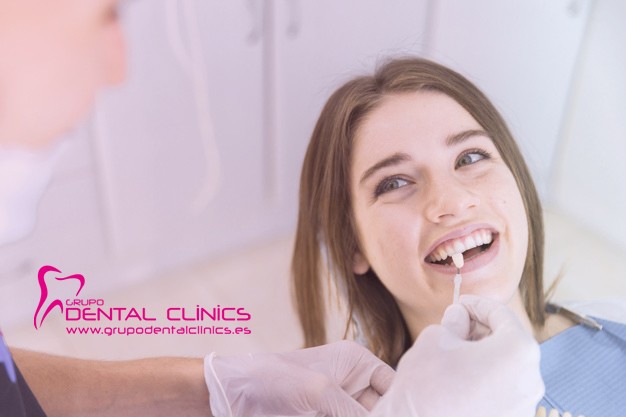All the stains on teeth they are usually one of the main reasons why many people do not feel comfortable with their smile. Why settle for these unsightly stains? Eliminating them is usually easier than it seems. Your dentist will be the one who, after examining your teeth, will advise you on the best treatment. Here we explain the type of stains that exist, how to avoid them and how to treat them.
Types of stains
Broadly speaking, we can divide them into:
- Extrinsic stains: They are the ones that are in the most superficial part of the tooth and they are usually the easiest to remove. They are normally produced by the contact of the teeth with pigmenting substances, present in food, drinks such as red wine, coffee, tea and products such as tobacco.
- Intrinsic stains: These appear on enamel or dentin. They tend to be more complex to remove and can be the result of a problem during the tooth formation phase. They can also be caused by the action of drugs such as tetracycline, enamel hypoplasia, vitamin deficiency, and fluorosis. This group also includes stains caused by the aging of the dentition.
Stains on teeth according to color
The stains on the teeth can also be grouped according to the color they present:
White spots. They can be motivated by various origins:
- Due to poor nutrition with a shortage of calcium or iron.
- It is also possible that it is due to some problem during the formation of the final teeth.
- Excess fluoride during childhood that causes fluorosis and stains the teeth.
- Sometimes they can be derived from poor oral hygiene, for example during orthodontic treatments, when removing the braces these stains may appear due to the accumulation of bacterial plaque. These types of spots can be the announcement of future cavities.
Yellow spots. These types of stains are perhaps the most common. Its appearance is usually associated with a deterioration of the enamel that, surely, also causes tooth sensitivity. Its origin is usually associated with:
- The intake of acidic foods, such as citrus fruits, vinegar, or other acids such as gastric juices or excess bleaching agents.
- Bruxism, excessive clenching of teeth leads to deterioration of the enamel.
- They can also be due to trauma, which has produced necrosis of the tooth and it has a yellowish color.
Brown spots. These stains are the most unsightly since they are the darkest compared to tooth enamel. Its main cause is due to excessive consumption of coffee, tea, red wine or tobacco. Apart from the dye, these substances alter the balance of the bacterial flora and therefore facilitate the formation of cavities or the development of periodontal problems. This alteration in the color of the teeth can also be due to the action of medications such as tetracyclines, an antibiotic widely used in the 60s and 70s to treat infections, which causes a brown to gray staining in the teeth.
Prevent the appearance of spots
Stains on teeth usually appear over the years. On some occasions, they will depend on external factors that we cannot control, but the most common is that they are due to factors related to our own hygiene or eating habits. Therefore, we can help prevent them by following some tips:
- The main cause of staining stems from a poor oral hygiene. It is advisable to brush your teeth after each meal, use dental floss and mouthwash before going to sleep.
- As we have previously pointed out ccertain foods or habits cause discoloration in our teeth. Avoid excessive consumption of red wine, coffee or tea.
- No Smoking: nicotine, tar and other substances found in cigarettes adhere strongly to the tooth causing stains.
- Whitening products smooth enamel so it reflects more light and appears whiter. Its proper use can help keep teeth shiny, but its abuse can deteriorate the enamel excessively and cause a negative effect.
- Go to a dental check-up and professional cleaning once a year.
Treatments to remove stains on teeth
Depending on the origin of the stains, the treatment will be different and must always be determined by the criteria of the dentist.
- In the case of superficial stains, a professional dental cleaning. A simple, painless treatment and with a single session can eliminate the spots.
- For more persistent stains, teeth whitening can be used by our dentist. In a single session we can achieve the desired result in a simple and painless way.
- In some cases when the discoloration is severe, the only solution will be the placement of dental veneers. Veneers are very thin layers that are placed on the surface of the tooth, and if the stain is very dark, the desired result may not be achieved simply by applying the veneer. For this reason, in more difficult to treat stains, a micro-abrasion treatment and teeth whitening may be necessary before proceeding with the application of the veneers. In cases where there is also an early onset of cavities, it will be necessary to heal the tooth.
We must remember that once the stains have been solved by our specialist it is important to follow the recommendations to maintain the results for a long time. Good habits to follow not only influence the aesthetics of your teeth but also improve your overall health. The only way to maintain optimal color in our teeth is to acquire good hygiene and eating habits and never apply home methods to combat stains without first consulting with your dentist.


